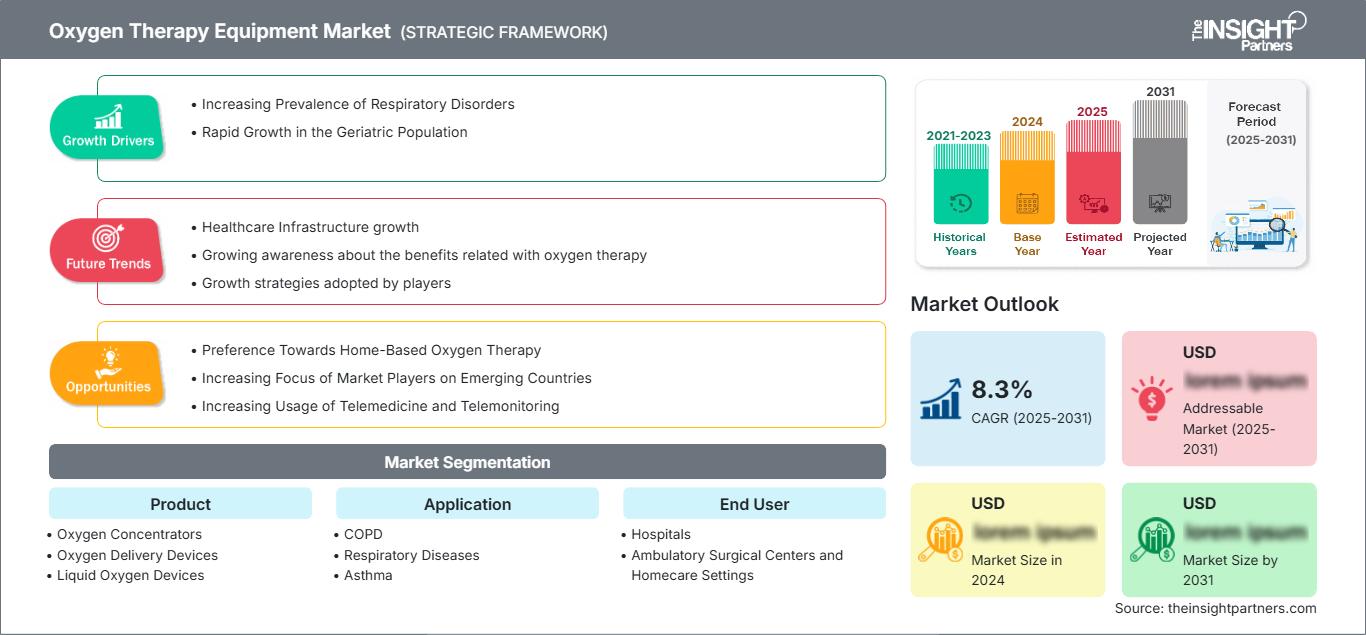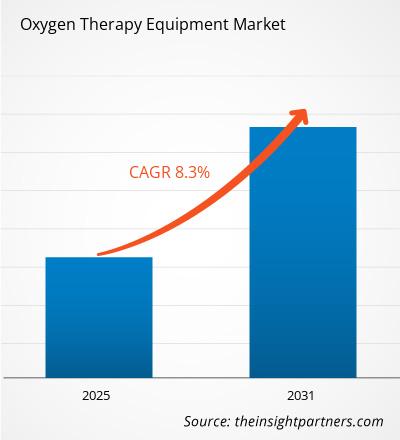Le marché des équipements d'oxygénothérapie devrait atteindre 5,6 milliards de dollars américains d'ici 2031. Il devrait enregistrer un TCAC de 6,5 % entre 2025 et 2031.
Le rapport est segmenté par produit (concentrateurs d'oxygène, dispositifs d'administration d'oxygène, dispositifs à oxygène liquide, bouteilles d'oxygène). Il présente également une analyse par application (BPCO, maladies respiratoires, asthme et autres) et par utilisateur final (hôpitaux, centres de chirurgie ambulatoire et soins à domicile). L'analyse mondiale est ensuite ventilée par région et par principaux pays. Les valeurs présentées dans le rapport sont exprimées en dollars américains.
Objectif du rapport
Le rapport sur le marché des équipements d'oxygénothérapie, réalisé par The Insight Partners, vise à décrire le paysage actuel et la croissance future, les principaux facteurs de croissance, les défis et les opportunités. Cela permettra d'éclairer divers acteurs économiques, tels que :
- Fournisseurs de technologies/Fabricants : Pour comprendre l'évolution de la dynamique du marché et identifier les opportunités de croissance potentielles, afin de prendre des décisions stratégiques éclairées.
- Investisseurs : Pour réaliser une analyse approfondie des tendances concernant le taux de croissance du marché, les projections financières et les opportunités tout au long de la chaîne de valeur.
- Organismes de réglementation : Pour encadrer les politiques et les activités du marché afin de minimiser les abus, préserver la confiance des investisseurs et garantir l'intégrité et la stabilité du marché.
Segmentation du marché des équipements d'oxygénothérapie : Produit
- Concentrateurs d'oxygène
- Dispositifs d'administration d'oxygène
- Dispositifs à oxygène liquide
- Bouteilles d'oxygène
Application
- BPCO
- Maladies respiratoires
- Asthme
- Autres
Utilisateur final
- Hôpitaux
- Centres de chirurgie ambulatoire et soins à domicile
Géographie
- Amérique du Nord
- Europe
- Asie-Pacifique
- Amérique du Sud et centrale
- Moyen-Orient et Afrique
Vous bénéficierez d’une personnalisation sur n’importe quel rapport - gratuitement - y compris des parties de ce rapport, ou une analyse au niveau du pays, un pack de données Excel, ainsi que de profiter d’offres exceptionnelles et de réductions pour les start-ups et les universités
Marché des équipements d'oxygénothérapie: Perspectives stratégiques

-
Obtenez les principales tendances clés du marché de ce rapport.Cet échantillon GRATUIT comprendra une analyse de données, allant des tendances du marché aux estimations et prévisions.
Facteurs de croissance du marché des équipements d'oxygénothérapie
- Prévalence croissante des troubles respiratoires : La pollution atmosphérique accrue et la sensibilité accrue aux allergènes aggravent les affections respiratoires, entraînant une demande plus forte d'oxygénothérapie. La coexistence de comorbidités telles que l'obésité ou d'autres maladies cardiaques est fréquente chez les personnes atteintes de troubles respiratoires et contribue donc fortement à cette demande. L'augmentation de l'incidence des troubles respiratoires (BPCO, asthme et autres affections pulmonaires) stimule le marché des équipements d'oxygénothérapie.
- Croissance rapide de la population gériatrique : L'un des principaux moteurs de la croissance du marché des équipements d'oxygénothérapie est le vieillissement rapide de la population. La demande d'oxygène est considérable dans cette tranche d'âge, car les personnes âgées sont plus susceptibles de souffrir de troubles respiratoires et de maladies chroniques. Par conséquent, l'évolution démographique a un impact sur les besoins en soins de santé et accroît la demande de systèmes d'administration d'oxygène, influençant ainsi l'offre de services. De plus, les progrès technologiques améliorent la commodité et la simplicité de l'administration de l'oxygénothérapie aux patients âgés, stimulant ainsi ce marché.
Tendances futures du marché des équipements d'oxygénothérapie
- Croissance des infrastructures de santé : De nombreux pays modernisent leurs établissements de santé, des hôpitaux aux centres de soins ambulatoires. Cela stimule la demande en équipements d'oxygénothérapie. De meilleures infrastructures permettent à un plus grand nombre de patients d'accéder aux traitements disponibles, dont l'oxygénothérapie. La croissance des infrastructures de santé est une tendance majeure du marché des équipements d'oxygénothérapie.
- Sensibilisation croissante aux bienfaits de l'oxygénothérapie : Grâce aux efforts des organismes de santé et des associations de défense des droits des patients pour sensibiliser le public aux bienfaits de l'oxygénothérapie dans le traitement des troubles respiratoires, les patients prennent davantage leur santé en main et s'informent sur les alternatives thérapeutiques, notamment l'oxygénothérapie, pour les maladies chroniques. La reconnaissance croissante de l'oxygénothérapie est l'une des principales tendances du marché des équipements d'oxygénothérapie.
- Stratégies de croissance adoptées par les acteurs du marché : Les entreprises investissent dans la R&D pour développer des dispositifs avancés et conviviaux, tels que les concentrateurs d'oxygène portables, afin de rendre les soins encore plus accessibles aux patients. Des partenariats solides avec les prestataires de soins de santé, les distributeurs et les entreprises technologiques assurent une large couverture des marchés tout en améliorant constamment la prestation de services. Les acteurs du marché ciblent de nouvelles zones géographiques dans les marchés émergents afin de toucher de nouveaux groupes de clients, stimulés par la demande croissante de soins respiratoires.
Opportunités du marché des équipements d'oxygénothérapie
- Préférence pour l'oxygénothérapie à domicile : Le traitement à domicile est privilégié par les patients car il leur garantit une qualité de vie optimale et une autonomie maximale. Les thérapies à domicile peuvent minimiser les coûts de santé en réduisant les hospitalisations et les consultations externes, ce qui en fait un choix attractif tant pour le patient que pour les prestataires de soins de santé. Cette évolution vers la thérapie à domicile ouvre de nouvelles perspectives de revenus pour les entreprises tout en stimulant l'innovation de nouveaux produits destinés à une utilisation à domicile. La demande croissante d'oxygénothérapie à domicile offre des opportunités aux entreprises du marché des équipements d'oxygénothérapie.
- Intérêt accru des acteurs du marché pour les pays émergents : La disponibilité d'équipements tels que les appareils d'oxygénothérapie augmente dans de nombreux marchés émergents qui se sont engagés dans l'amélioration de leur système de santé. De nombreux gouvernements mettent en place des programmes visant à améliorer la santé respiratoire et à faciliter l'accès à l'oxygénothérapie, stimulant ainsi la croissance du marché. Cibler ces marchés émergents, et notamment conquérir de nouveaux marchés, devrait permettre aux entreprises de dynamiser le secteur des équipements d'oxygénothérapie.
- Utilisation croissante de la télémédecine et de la télésurveillance : La télésurveillance permet aux professionnels de santé de suivre en temps réel le taux de saturation en oxygène d'un patient ainsi que son état général, permettant ainsi une intervention et un ajustement immédiats du traitement. La télémédecine encourage la communication entre patients et professionnels de santé, ce qui améliore l'observance du traitement et les résultats cliniques. Lorsqu'on examine le rôle des entreprises sur le marché des équipements d'oxygénothérapie, l'utilisation de la télémédecine et de la télésurveillance augmente considérablement, ce qui représente une opportunité.
Marché des équipements d'oxygénothérapie
Les analystes de The Insight Partners ont analysé en détail les tendances régionales et les facteurs influençant le marché des équipements d'oxygénothérapie tout au long de la période prévisionnelle. Cette section aborde également les segments et la répartition géographique du marché de la gestion des troubles du rythme cardiaque en Amérique du Nord, en Europe, en Asie-Pacifique, au Moyen-Orient et en Afrique, ainsi qu'en Amérique du Sud et centrale.
Portée du rapport sur le marché des équipements d'oxygénothérapie
| Attribut de rapport | Détails |
|---|---|
| Taille du marché en 2024 | US$ XX Billion |
| Taille du marché par 2031 | US$ 5.6 Billion |
| TCAC mondial (2025 - 2031) | 6.5% |
| Données historiques | 2021-2023 |
| Période de prévision | 2025-2031 |
| Segments couverts |
By Produits
|
| Régions et pays couverts |
Amérique du Nord
|
| Leaders du marché et profils d'entreprises clés |
|
Densité des acteurs du marché des équipements d'oxygénothérapie : comprendre son impact sur la dynamique commerciale
Le marché des équipements d'oxygénothérapie connaît une croissance rapide, portée par une demande croissante des utilisateurs finaux, elle-même alimentée par l'évolution des préférences des consommateurs, les progrès technologiques et une meilleure connaissance des avantages du produit. Face à cette demande grandissante, les entreprises élargissent leur offre, innovent pour répondre aux besoins des consommateurs et tirent parti des tendances émergentes, ce qui stimule davantage la croissance du marché.

- Obtenez le Marché des équipements d'oxygénothérapie Aperçu des principaux acteurs clés
Points clés de vente
- Couverture exhaustive : Ce rapport analyse en détail les produits, services, types et utilisateurs finaux du marché des équipements d’oxygénothérapie, offrant ainsi une vision globale.
- Analyse d’experts : Ce rapport repose sur une connaissance approfondie du secteur et des analystes.
- Informations actualisées : Grâce à sa couverture des informations et tendances les plus récentes, ce rapport garantit la pertinence de vos analyses.
- Options de personnalisation : Ce rapport peut être personnalisé pour répondre aux besoins spécifiques de vos clients et s’adapter parfaitement à vos stratégies commerciales.
Ce rapport d’étude de marché sur les équipements d’oxygénothérapie peut donc vous aider à décrypter et comprendre le contexte sectoriel et les perspectives de croissance. Malgré quelques points à améliorer, les avantages de ce rapport l’emportent généralement sur les inconvénients.
- Analyse historique (2 ans), année de base, prévision (7 ans) avec TCAC
- Analyse PEST et SWOT
- Taille du marché Valeur / Volume - Mondial, Régional, Pays
- Industrie et paysage concurrentiel
- Ensemble de données Excel
Rapports récents
Témoignages
Raison d'acheter
- Prise de décision éclairée
- Compréhension de la dynamique du marché
- Analyse concurrentielle
- Connaissances clients
- Prévisions de marché
- Atténuation des risques
- Planification stratégique
- Justification des investissements
- Identification des marchés émergents
- Amélioration des stratégies marketing
- Amélioration de l'efficacité opérationnelle
- Alignement sur les tendances réglementaires






















 Obtenez un échantillon gratuit pour - Marché des équipements d'oxygénothérapie
Obtenez un échantillon gratuit pour - Marché des équipements d'oxygénothérapie